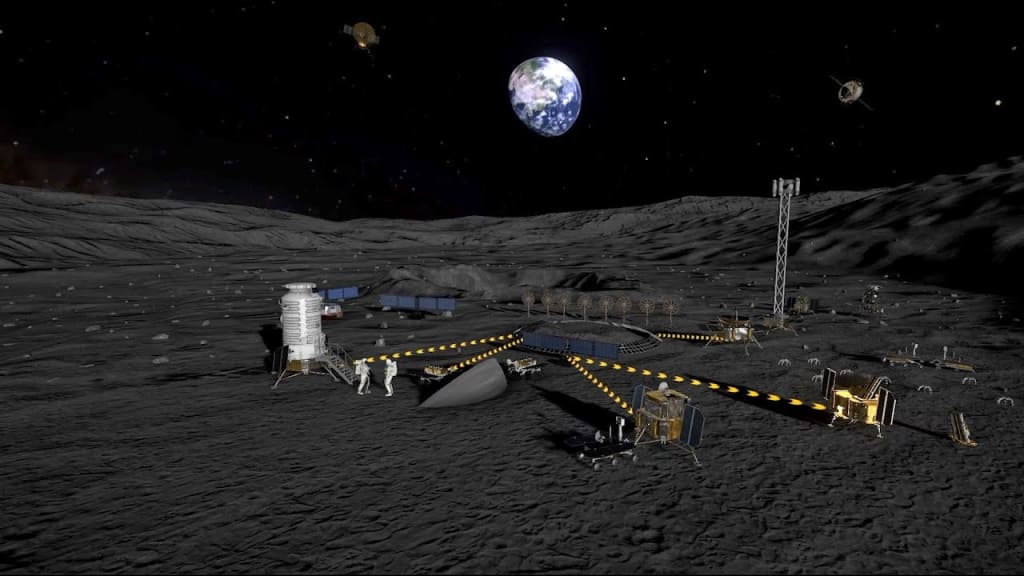
Introduction :
A major step forward in space exploration would be achieved if China were to create a lunar base. This enormous endeavour fits into China's larger plan to dominate space technology and exploration.
The creation of a space station in orbit around the Earth and the launch of multiple successful lunar missions are just two examples of the considerable advancements the Chinese government has already made in this field.In China, experts first gathered to discuss the possibility of establishing a crewed base on the moon.
Mission :
Over 100 experts from domestic universities, research institutes, and space contractors attended the Extraterrestrial Construction Conference on Saturday at Huazhong University of Science and Technology in Wuhan.
According to rumours in the Chinese media, the massive project, which would employ hundreds of scientists, engineers, and space contractors, might start as soon as this decade. According to local media, the specifics were discussed at a meeting in Wuhan, China, where attendees discussed how to build infrastructure on the moon.
Many specifics of the lunar outpost project still need to be worked out because it is still in its early phases. China has nonetheless made it known that it intends to construct a permanent facility on the moon that would function as a research station and a launch site for upcoming expeditions to other regions of the solar system.
A lunar base's advantageous position would be one of its main advantages. Due to its low gravity and absence of an atmosphere, the moon makes a perfect starting point for space research. China could study the moon and its possibilities from a base on the moon while also conducting research and development on new space technologies.
According to rumours in the Chinese media, the massive project, which would employ hundreds of scientists, engineers, and space contractors, might start as soon as this decade. According to local media, the specifics were discussed at a meeting in Wuhan, China, where attendees discussed how to build infrastructure on the moon.
China seems to want to build things first before sending people. The Chang'e 8 mission may transport the first brick to the moon within the next 10 years as a technological test, but it might take much longer for people to settle there, according to Yu Dengyun from the China Aerospace Science and Technology Corporation.
A lunar outpost might also be an important first step for future journeys to Mars and other locations in the solar system. A permanent human presence on Mars is numerous space agencies' long-term objective, including NASA. A lunar base would be a crucial first step towards reaching this objective since it would serve as a proving ground for innovative space exploration techniques and technology.
Regarding the schedule or detailed plans for the lunar base project, China has not made many announcements. However, the project is probably going to take a long time to finish and will cost a lot to investigate and create.
According to Yu, who spoke at the conference, "It might take us 20 to 30 years or longer to settle down on the moon, but we must start working together now."
In order to look for water ice behind craters, Chang'e 7 will be launched the following year and land in the South Pole-Aitken Basin.
In the year 2028, the Chang'e 8 spacecraft will make its lunar landing and investigate resource utilisation techniques. It will test crucial technologies alongside Chang'e-7 to open the door for a future lunar research station.
The construction of a lunar base is not without its difficulties. New materials and technologies would need to be developed to withstand the harsh lunar environment's dramatic temperature swings and radiation exposure to protect astronauts and other base workers' safety and health. Additionally, it could be extremely expensive to launch supplies and equipment to the moon. This could be a major financial obstacle.
Despite these obstacles, China's development of a lunar outpost would be a significant turning point in space exploration. It would serve as a testament to the nation's expanding technological might and its dedication to expanding the frontiers of human knowledge and comprehension. It will be intriguing to watch how China manages the numerous difficulties posed by erecting a permanent base on the moon as the project develops, as well as how it makes use of the base to further its astral technological and scientific ambitions.
The Chang'e-4 lunar lander became the first spacecraft to touch down on the far side of the moon, where it started to explore hitherto unexplored terrain. This achievement highlights China's desire to become a global leader in space research.
In order to colonise and utilise space, Chinese scientists have long held aspirations to build a manned lunar base and launch nuclear-powered rockets into orbit. The landing on Thursday represented a tiny but profoundly symbolic advance in that direction.
According to the China National Space Administration, which released a colour image of the moon's flat surface, Chang'e-4, carrying a 300-pound lunar rover with probes and spectrometers, touched down at the Von Karman crater in the South Pole-Aitken basin.
The negative press surrounding China's space programme has frequently overshadowed the steady advancements. One of China's two orbiting space stations, Tiangong-1, dropped back to Earth earlier this year, and the country's first private rocket failed to put it into orbit in October. Two Long March rocket missions the year before ended in failure. But China successfully accomplished a number of rocket launches last year.
According to Namrata Goswami, an independent space specialist, Chang'e-4 demonstrates China's commitment to completing space travel schedules and goals. She noted that Chinese space scientists set a 2018 timetable for a far-side lunar landing years ago.
Especially noteworthy are China's aspirations for the moon and space, which include plans for a Chinese research base.
Chinese officials hardly ever speak about the country's ambitious space plans, but in late 2017, the state-run People's Daily detailed the plans of the country's rocket manufacturer, the China Academy of Launch Vehicle Technology, which included plans to build a fleet of nuclear-powered space shuttles by the 2040s for frequent space flights to other planets.
China's Made in China 2025 programme, which aims to achieve global leadership in space travel by the middle of the century, includes space exploration as a significant component. Following its censorship by the government last year amid rising trade tensions between the two countries, Chinese officials and state media have recently stopped using the phrase.
Analysts do not anticipate China to give up its ambition to become a world leader in strategic technologies, such as rockets, robotics, and artificial intelligence, despite growing hopes that the two countries may come to an agreement to end the trade war.
References : India Today - https://t.ly/hhyw
Indian Express - https://t.ly/MPQ1f
About the Creator
Gokul
One of the things that sets Gokul apart as a writer is his ability to connect with readers on a personal level. He has a natural flair for writing in a conversational and relatable style that makes even complex topics






Comments
There are no comments for this story
Be the first to respond and start the conversation.